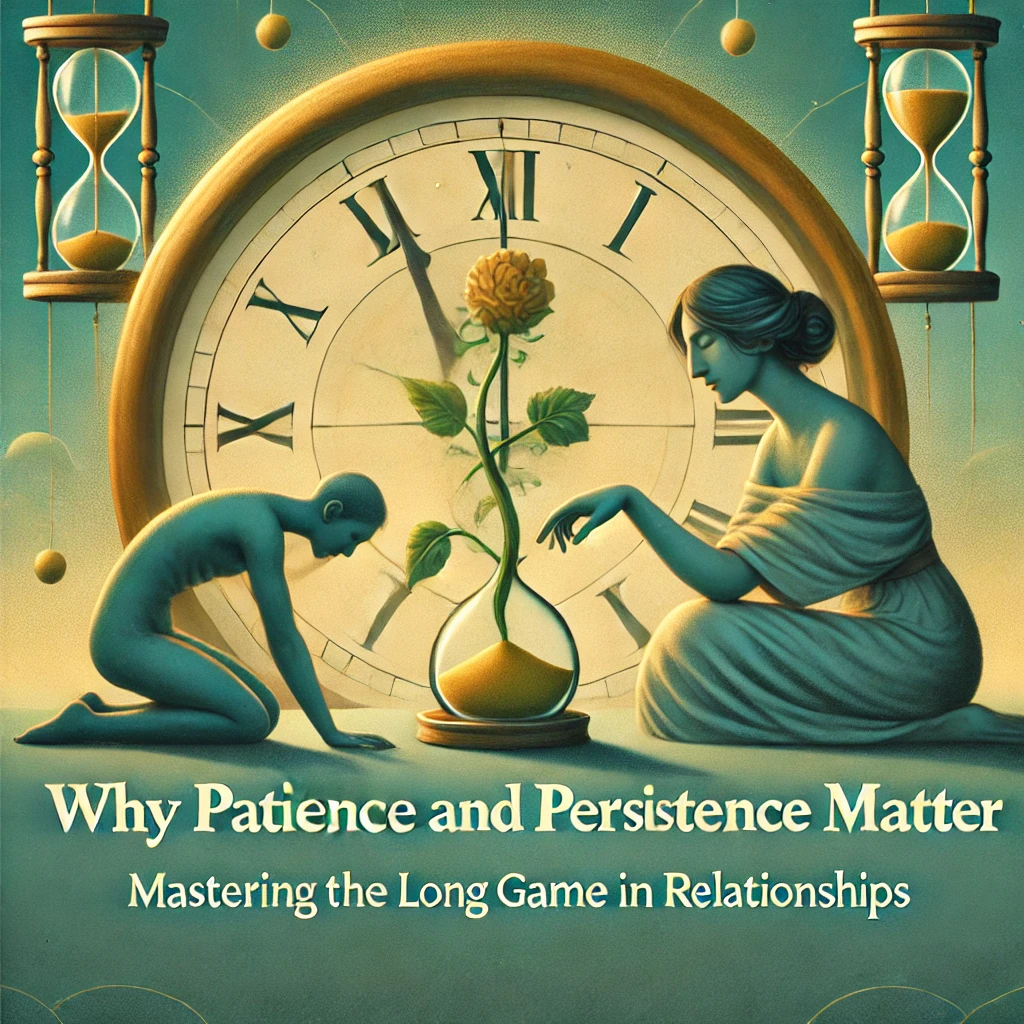In a world where we are constantly bombarded with quick-fix solutions and instant gratification, the art of patience and persistence is often overlooked. But when it comes to influencing a relationship and gently guiding it toward the outcomes you desire, playing the long game is not just important—it’s essential. As discussed in Chapter 9 of “Mastering Him: The Secret Art of Gentle Control in Relationships”, understanding the subtle power of patience and persistence can be the difference between short-term manipulation and lasting influence.
You might be wondering, why is patience such a critical element of control in a relationship? The answer is simple: without it, your efforts to influence will feel forced, desperate, and ultimately, ineffective. Manipulation that happens too quickly or too aggressively raises red flags and triggers defensiveness. But when you’re patient—when you allow your partner to feel as though they’re coming to conclusions on their own, or when you gradually introduce changes over time—your influence feels natural, even invisible.
In Chapter 9, the book dives deep into how to master this subtle yet powerful art of persistence. This is the chapter that will teach you how to influence your partner’s behavior without them even realizing they’re being influenced. It’s not about pushing or pressuring—it’s about making small, intentional moves and letting time do the rest. Whether you’re trying to influence major life decisions or simple everyday routines, this long game strategy ensures that the results stick. Let’s break down why patience and persistence are such powerful tools and how they can change the way you approach your relationship.
Patience: The Power of Letting Time Work in Your Favor
Patience is the ultimate sign of control—not just over your partner, but over yourself. It’s about understanding that real influence doesn’t happen overnight. Think about it: when someone tries to change your behavior or make you do something right away, what’s your first instinct? Resistance. No one likes feeling manipulated or controlled, especially in a romantic relationship.
But when you approach influence with patience, you remove that resistance. You’re no longer pushing your partner toward a desired outcome—instead, you’re guiding them slowly, almost imperceptibly, in that direction. You allow them to feel like they’re making their own choices, which is far more powerful than forcing them into a decision.
Example of Patience in Action:
Let’s say you want your partner to start taking more initiative in planning date nights. If you push for it directly, they may resist, feeling like they’re being pressured or criticized. But if you subtly mention how much you love when they take the lead in small conversations, and you encourage them when they do take initiative, you’re gradually planting the seed. Over time, your partner will start planning dates more often—not because you demanded it, but because they feel like it’s something they chose to do.
Persistence: Making Your Influence Stick Over Time
While patience is about giving your partner the space to come around to your way of thinking, persistence is what ensures that your influence has staying power. It’s not enough to make subtle suggestions once and hope for the best—you have to be consistent. Persistence is about regularly reinforcing the changes you want to see without being pushy or overbearing.
Persistence requires subtlety and finesse. It’s about keeping your desired outcomes in your partner’s awareness without making them feel like they’re being pressured or manipulated. Over time, the repetition of small, gentle suggestions or actions will begin to shape their behavior, attitudes, and decisions. It’s a long-term investment in your relationship’s future.
Example of Persistence in Action:
Imagine you want your partner to start working on their health and fitness. Instead of bombarding them with diet plans or gym memberships, you start small. You suggest going for walks together or cooking healthier meals at home. You compliment them when they make healthy choices. The key here is consistency. Week after week, you subtly reinforce the importance of health without ever making it feel like an obligation. Eventually, your partner may start taking these initiatives on their own, believing it was their decision all along.
Why Patience and Persistence Are More Powerful Than Direct Manipulation
Here’s the truth that most people don’t want to hear: direct manipulation rarely works in the long run. It might get you short-term results, but it almost always backfires. When people feel manipulated, they become defensive, resentful, and eventually, they may rebel against the very changes you’re trying to create.
Patience and persistence, on the other hand, create lasting influence. By playing the long game, you make your partner feel comfortable with the changes you’re introducing. They won’t feel pressured or controlled because the shifts are happening gradually, and they’ll feel like they’re part of the decision-making process. This approach not only strengthens your relationship but also ensures that the changes stick.
Here’s the controversial part: Many people want to believe that relationships should be based entirely on honesty and openness. And while that’s true in many respects, the idea that all influence must be direct is a fantasy. In reality, subtle influence—rooted in patience and persistence—is what drives most long-term changes in relationships. You’re not being dishonest by playing the long game; you’re simply working with the natural ebb and flow of human behavior.
Why You Need to Master Patience and Persistence Now
Here’s why mastering patience and persistence matters: relationships are marathons, not sprints. Trying to force quick changes only breeds resentment, frustration, and conflict. But when you take the time to understand how influence really works—when you let patience and persistence be your guiding principles—you can shape your relationship in ways that feel natural and lasting.
Chapter 9 of “Mastering Him: The Secret Art of Gentle Control in Relationships” gives you the practical tools you need to make this work. It’s not about manipulation in the traditional sense; it’s about understanding the psychology behind influence and using it to create a relationship dynamic that benefits both of you. With patience and persistence, you can steer your relationship in a direction that makes both you and your partner happier—without them ever feeling manipulated.
Q&A
- Why is patience important in relationships?
- Answer: Patience allows for gradual influence, helping changes feel natural rather than forced, which builds a stronger, more resilient connection.
- How can persistence improve my relationship?
- Answer: Consistent, gentle reinforcement over time helps ideas or habits to take root in a way that feels effortless and enduring.
- What is the long game in relationships, and why does it matter?
- Answer: The long game involves shaping the relationship through small, intentional actions over time, resulting in lasting, meaningful influence.
- How does patience help in influencing my partner without manipulation?
- Answer: By using patience, you give your partner time to adjust to ideas organically, helping influence feel collaborative rather than coercive.
- What are the benefits of persistence in relationships?
- Answer: Persistence reinforces desired outcomes consistently, making changes stick without pressure or conflict.
- How can I influence my partner gently and effectively?
- Answer: Using patience and persistence allows you to create positive changes gradually, making them feel like mutual choices.
- Why do quick fixes fail in relationships?
- Answer: Quick fixes often lead to resistance and defensiveness, while patience allows change to happen naturally, enhancing long-term success.
- How does gentle control work in relationships?
- Answer: Gentle control uses subtle cues and consistent reinforcement, helping guide your partner’s behavior in a way that feels supportive, not controlling.
- What is the difference between influence and manipulation in relationships?
- Answer: Influence focuses on mutual benefits and subtle, positive guidance, whereas manipulation often uses pressure or deceit for one-sided gain.
- How can I shape my partner’s behavior without causing conflict?
- Answer: Through patience and persistence, you can influence your partner’s behavior gradually, allowing change to feel collaborative and conflict-free.
Are You Ready to Master the Art of Influence in Your Relationship?
If you’re ready to dive deeper into the power of patience and persistence, then it’s time to pick up “Mastering Him: The Secret Art of Gentle Control in Relationships.” Chapter 9 will show you how to play the long game in your relationship, creating lasting change without conflict or pressure.
This book isn’t just another relationship guide—it’s about mastering the subtle art of influence. Whether you’re looking to gently shape your partner’s habits, decisions, or even their way of thinking, this book will give you the tools you need to do it effortlessly.
Get your copy today, and start mastering the art of gentle control in your relationship—because real influence is built on patience, persistence, and understanding how to play the long game.
Read more about the book: https://developmentpill.com/mastering-him-the-secret-art-of-gentle-control-in-relationships-a-guide-to-influence-hell-never-see-coming/
Book Link: https://www.amazon.com/dp/B0DKKGLZQ9
Book Link UK: https://www.amazon.co.uk/dp/B0DKKGLZQ9



